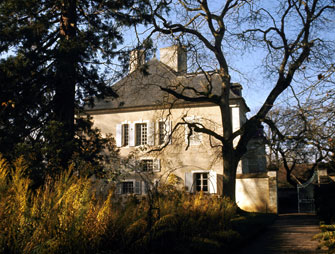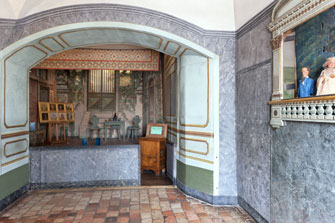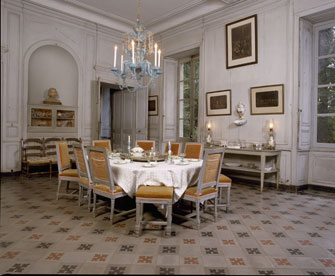At Home with George …
And Frédéric, Franz, Eugène …

George Sand’s House in Nohant. © Etienne Revault-CMN
In 1821, a 17-year-old girl named Amantine-Lucile-Aurore Dupin, who would one day become George Sand, inherited a small manor house, the Manoir de Nohant, from her grandmother, the aristocratic (though illegitimate) Marie-Aurore de Saxe, Madame Dupin de Francueil.
Nohant, located in the heart of France not far from the market town of Chateauroux, first served as Sand’s rural retreat from her life in Paris, but she eventually settled there and was buried on the property after she died in 1876. An exhibition, “George Sand’s Salon,” has just opened at the house in Nohant, in partnership with the Château de Versailles.
This was no ordinary writer’s house, however: it was a favored gathering place for the literary, musical and artistic elite of the time, a haven for such glittering names of the era as Chopin, Liszt, Balzac, Delacroix, Flaubert, Dumas (fils) and Turgenev. All were her friends, and some her lovers. Now a museum, the estate resonates with memories and memorabilia of its cultured residents and visitors.
Sand carved out a niche for herself as one of the leading Romantic novelists of the 19th century and one of the first French women writers to establish an international reputation.

“Portrait of George Sand” (detail), by Auguste Charpentier. © Pascal Lemaître-CMN
She also carved herself a more sulfurous reputation as a liberated woman in an unliberated era. She is probably best known for her relationship with Chopin, which lasted 10 years and during which he wrote some of his finest music. Her intense, colorful life captures the imagination and evokes the essence of European culture in a gilded age. To visit Nohant is to take a fascinating step into the world of this prolific writer.
George Sand was wealthy and successful, earning a significant fortune from her writing, a rare enough achievement for a woman in that or any other time. She was, in fact, the highest-paid writer of the period. She wanted to claim her artistic liberty and prove that a woman could succeed as well as a man as a writer. She was also a rebel far ahead of her time, dressing as a man, assuming a man’s name and even smoking a pipe. After the breakdown of her marriage to Casimir Dudevant in 1831, she freely engaged in relationships with both men and women.
At Nohant, time has stood still. Almost everything remains as it was or has been restored to its 19th-century state. Sand found the inspiration and subject matter for her many novels and travel books in the life and carryings-on of the people in the countryside around her. She loved the rustic landscape and her neighbors in the Berry region, and they loved her back.
For the exhibition, the Château de Versailles has loaned several portraits of the artists and literary lions who frequented the house, including paintings of Flaubert, Dumas and Chopin, and a bust of Delacroix. Displayed in the dining room, they add a little historical gloss to the mise en scene, although as artworks they are mediocre.
Chopin is said to have written something like two-thirds of his music while living with Sand at Nohant. It was he who had the idea of building a miniature theater in a side room where family and friends could produce plays to while away long winter evenings. At least

The puppet theater at Nohant. © Colombe Clier-CMN
100 performances were held there, and the last stage set remains in situ. In the same room, there is also a puppet theater made by Sand’s son Maurice. She herself dressed the puppets: when not masquerading as a man, she loved to sew.
Sand’s ground-floor bedroom, with its small desk hidden in a cupboard, is untouched. She worked there daily until the bell rang to summon the household to dinner (formal dress required) and the evening’s entertainment. Visitors are not allowed to enter the bedroom, but they can see her desk reflected in a mirror when they look through the open door.
The table in the dining room is laid with a set of yellow and turquoise glasses said to have

The dining room. © Alain Longchampt-CMN
been designed and given to Sand by Delacroix. In the salon next door, adorned with a pretty Venetian chandelier, family portraits decorate the walls.
The attic was transformed into an artist’s studio for Maurice, whose art teacher was none other than Delacroix. The upper bedrooms, which also retain their original decor, can be visited as well.
Tours of the estate and its extensive gardens are available with friendly guides who are full of information and anecdotes. In the gatehouse, there is a restaurant that serves a good light lunch.
Getting to Nohant from Paris is difficult without a car, but it’s worth the effort for anyone who appreciates George Sand, perhaps not for her work, which few people read today, but for her extraordinary life and courage. If you haven’t read a biography of her, try George Sand: A Woman’s Life Writ Large, by Belinda Jack (Vintage). You will surely be moved by this visit to her private life at Nohant.
For a glimpse of Sand’s world without leaving Paris, pay a visit to the Musée de la Vie Romantique, in the 9th-arrondissement house where her friend and neighbor, the artist Ary Sheffer, lived, and in whose studio Chopin often played.
Domaine de George Sand: 36400 Nohant-Vic. Tel.: 02 54 31 06 04. Open 9:30am-1pm and 2pm-6:30pm (in July and August; see website for hours at other times of the year). Admission: €7.50. maison-george-sand.monuments-nationaux.fr
Click here to read all of this week’s new articles on the Paris Update home page.
Reader Panama Red writes: “A few years back I had the honor of performing in the small village of Château Chinon for a couple of summer festivals with my friend Rob ‘the Doc’ Dokter. Walking around the hilly little country town, moving our stuff from one stage to the next, I was, as a righteously indignant American, shocked (shocked I tell you) to discover that the local elementary school had been named for this wanton woman of letters. Stands out as a highlight of that trip of highlights, and a delightful contrast of values between France and the U.S.”
Reader Perci Chester writes: “I read many of her novels when I was a teenager – loved them – and would love to visit this museum when I am next in Paris. Wonderful article. Thanks!”
Reader Reaction: Click here to respond to this article (your response may be published on this page and is subject to editing).
Support Paris Update by ordering books from Paris Update’s Amazon store at no extra cost. Click on your preferred Amazon location: U.K., France, U.S.
© 2014 Paris Update
Favorite